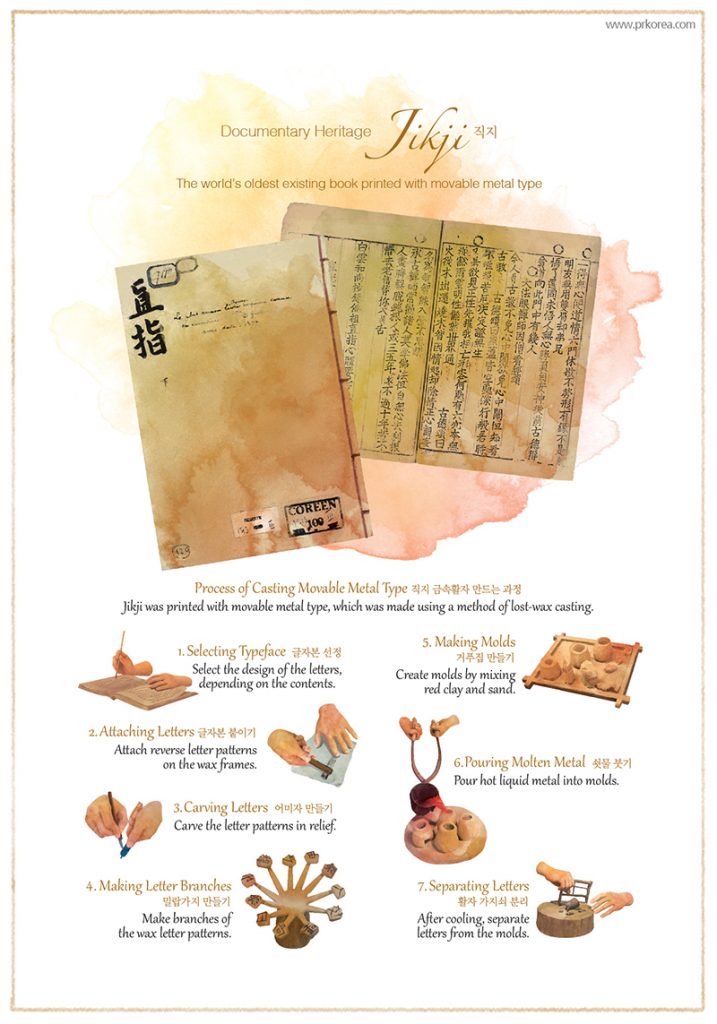
1. Documentary Heritage_Jikji
Jikji is the world’s oldest existing book printed with movable metal type. It was printed at a Buddhist temple in 1377 during the Goryeo Dynasty (918-1392). It was during this period, around 1200, when the first movable metal type printing technique in the world was invented. Besides Jikji, Korea has many other items of documentary heritages, including Mugujeonggwang Daedaranigyeong, which is the world’s oldest surviving book printed with woodblocks. These examples illustrate the Korean people’s strong interest in knowledge and information and their high technical capacity. Now, in the 21st century, Korea is the world leader of Information Technology. This is a manifestation of Korea’s advanced technological tradition that led to movable type and printing technology developments.
※ Process of Casting Movable Metal Type
Jikji was printed with movable metal type, which was made using a method of lost-wax casting.
① Selecting Typeface: Select the design of the letters, depending on the contents.
② Attaching Letters: Attach reverse letter patterns on the wax frames.
③ Carving Letters: Carve the letter patterns in relief.
④ Making Letter Branches: Make branches of the wax letter patterns.
⑤ Making Molds: Create molds by mixing red clay and sand.
⑥ Pouring Molten Metal: Pour hot liquid metal into molds.
⑦ Separating Letters: After cooling, separate letters from the molds.
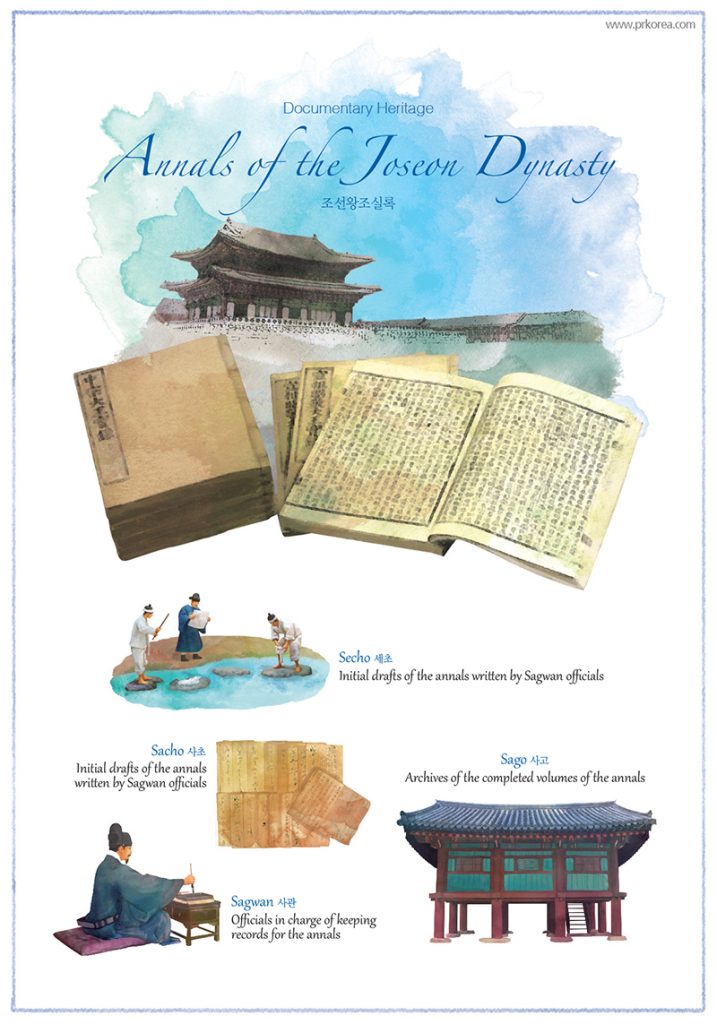 2. Documentary Heritage_Annals of the Joseon Dynasty
2. Documentary Heritage_Annals of the Joseon Dynasty
The Annals of the Joseon Dynasty is a chronicle of the Joseon Dynasty (1392-1910) that covers the reigns of 25 kings during 472 years of its history in 1,893 volumes of 888 books. They include extensive descriptions of various aspects of politics and society during the period, including occurrences of natural disasters. The annals deserve to be called an encyclopedia of the Joseon Dynasty. They are particularly recognized for their objectivity. Official historians called Sagwan were in charge of keeping the records, and even kings were restricted from reviewing them in order to protect their integrity. The annals have been widely researched in many different fields. The strong commitment to recording objective history still inspires the Korean people today.
Sagwan: Officials in charge of keeping records for the annals.
Sacho: Initial drafts of the annals written by Sagwan officials.
Secho: Rituals for destroying Sacho drafts after compiling the annals.
Sago: Archives of the completed volumes of the annals.
 3. Traditional Martial Arts_Taekwondo
3. Traditional Martial Arts_Taekwondo
Taekwondo is Korea’s traditional martial art and sport. It is a global and Olympic sport that has gained worldwide popularity. As of March 2014, the World Taekwondo Federation (WTF) has 206 member nations. Taekwondo is a kind of martial art that only uses hands and feet and no other weapons. It is characterized by a variety of powerful kicks. Taekwondo emphasizes the discipline of both body and mind, as well as respect for others.
 4. Traditional Martial Arts_Ssireum
4. Traditional Martial Arts_Ssireum
Ssireum is Korea’s traditional folk game and national sport. Two wrestlers hold on to each other’s Satba, which is a band tied around the waist and thigh. The goal is to take the opponent down to the ground using strength and grappling techniques. Since Ssireum is not restricted to a location or a facility, it has long been practiced for everyday physical training and as a part of folk games on traditional holidays, such as Dano on May 5th of the lunar calendar. Depending on the region, either left-hand or right-hand Ssireum was practiced. Nowadays, left-hand Ssireum has become the standard. National competitions are held every year.
Satba: a colored cloth wrapped around the waist and thigh during Ssireum
Front Knee Strike: takedown by hitting an opponent’s knee with one’s hand.
Inner Leg Hook: takedown by hooking an opponent’s left leg with one’s right leg.
Outer Leg Hook: takedown by hooking an opponent’s right leg with one’s right leg.
Body Throw: takedown by lifting and throwing an opponent’s body to the ground.
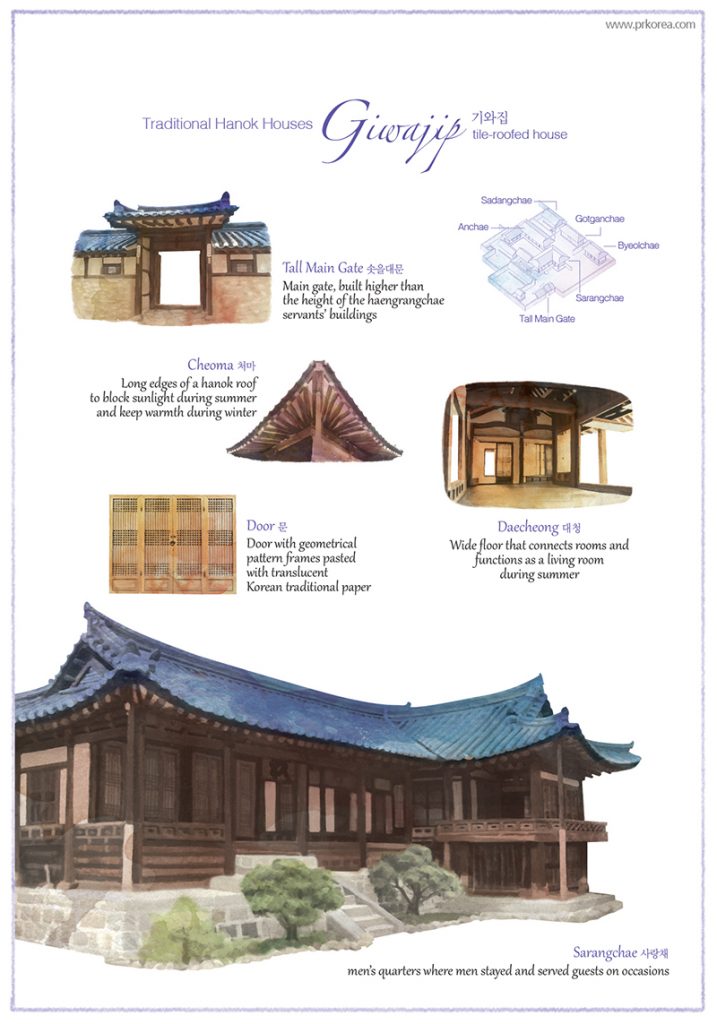 5. Traditional Hanok House_ Giwajip tile roofed house
5. Traditional Hanok House_ Giwajip tile roofed house
Hanok is Korea’s traditional type of housing. Korea has four distinct seasons with a relatively long summer and winter. Reflecting such climatic characteristics, Hanok is furnished with a wood floor and an underfloor heating system. Korea’s heating system, called Ondol, traces back to Goguryeo (37 B.C.-A.D. 668). The Ondol system functions by warming up the floor through heating underfloor stone slabs, or nowadays, underfloor water pipes. Among Hanok, Giwajip or tile-roofed houses were inhabited by the nobility. The space was clearly divided into separate quarters by one’s hereditary status, gender, and age: Anchae, Sarangchae, and Haengrangchae.
Tall Main Gate: main gate, built higher than the height of the haengrangchae servants’ buildings.
Door: door with geometrical pattern frames pasted with translucent Korean traditional paper
Cheoma: long edges of a hanok roof to block sunlight during summer and keep warmth during winter.
Daecheong: Wide floor that connects rooms and functions as a living room during summer.
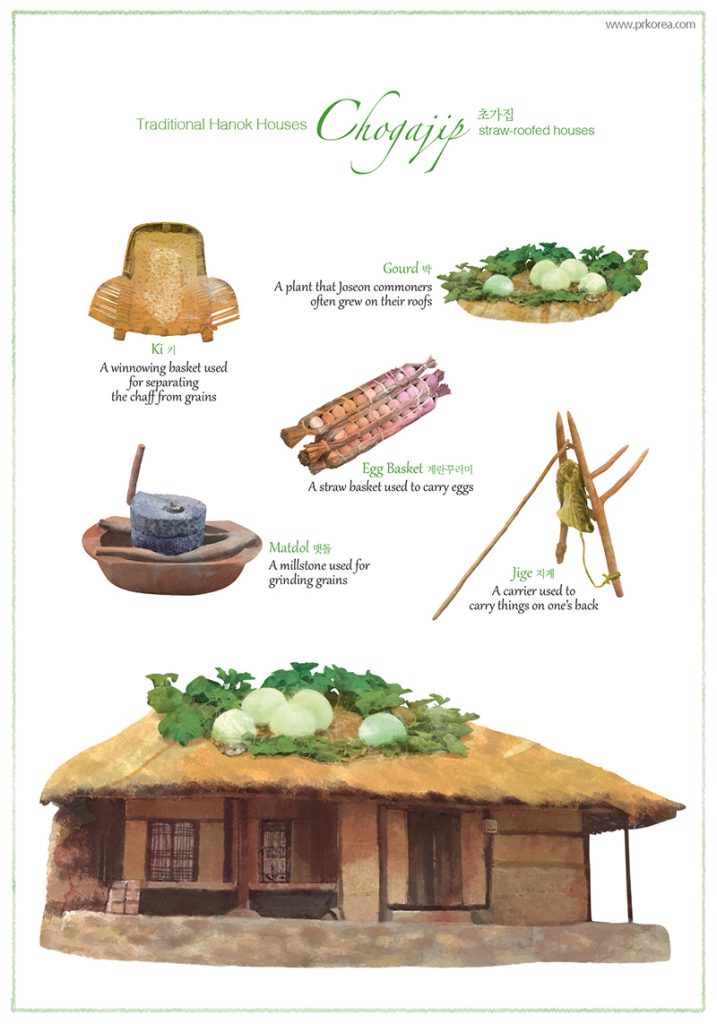 6. Traditional Hanok House_ Chogajip straw-roofed house
6. Traditional Hanok House_ Chogajip straw-roofed house
Korea’s traditional Hanok housing emphasizes harmony with nature. Hanok buildings were built of natural materials, such as wood, soil, and stone, with careful consideration not to damage the surrounding natural landscape. The interior, including walls, floors, and windows, was finished with Korean traditional paper called Hanji. Among Hanok, Chogajip or straw-roofed houses were inhabited by commoners. Commoners grew gourds on their roofs, and the roofs were made in the shape of mountains to be in harmony with the surrounding landscape. Unfortunately, Chogajip buildings have disappeared since the 1970s during Korea’s rapid economic development.
Gourd: A plant that Joseon commoners often grew on their roofs.
Egg Basket: A straw basket used to carry eggs.
Jige: A carrier used to carry things on one’s back.
Matdol: A millstone used for grinding grains.
Ki: A winnowing basket used for separating the chaff from grains.
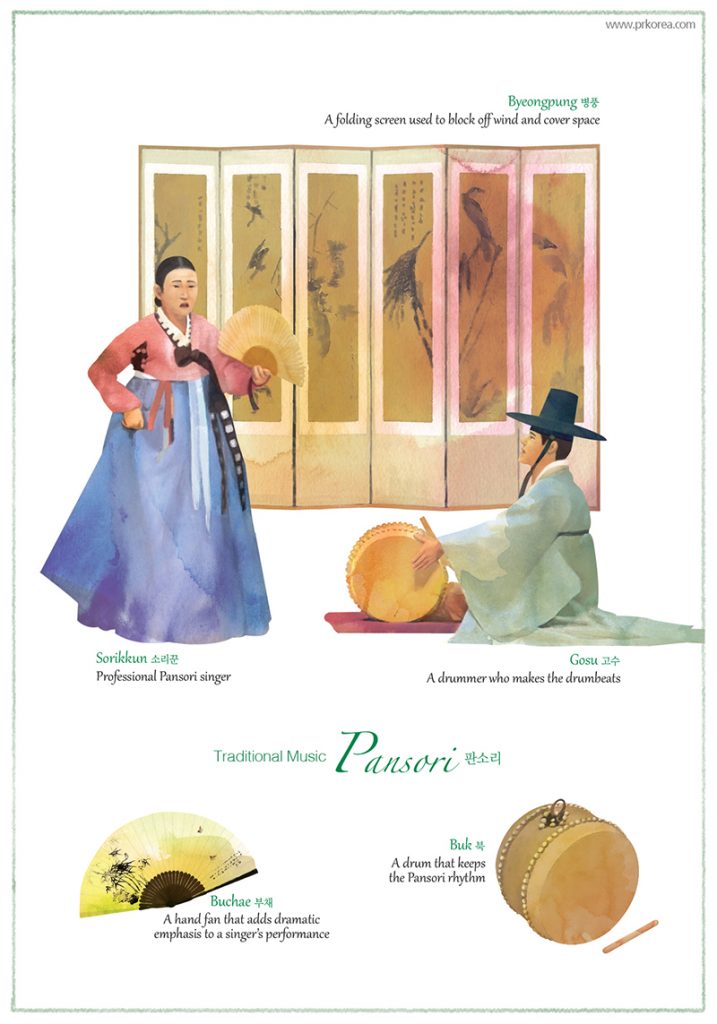 7. Traditional Music_Pansori
7. Traditional Music_Pansori
Pansori is Korea’s traditional music genre, which is performed by one singer to the drum beats of a drummer, called Gosu. The singer combines narrative and gesture with singing, while the audience responds and participates in the performance. Audience participation brings a unique spontaneity, which is Pansori’s key characteristic. The singer modifies the length and format of the performance, depending on the reactions of the audience. Since Pansori narratives were based on folk tales and stories, they were typically about the lives and feelings of commoners. Among the twelve original pieces, only five remain today. Chunhyangga is the most famous one.
Sorikkun: Professional pansori singer
Gosu: A drummer who makes the drumbeats
Byeongpung: A folding screen used to block off wind and cover space
Buchae: A hand fan that adds dramatic emphasis to a singer’s performance
Buk: A drum that keeps the pansori rhythm
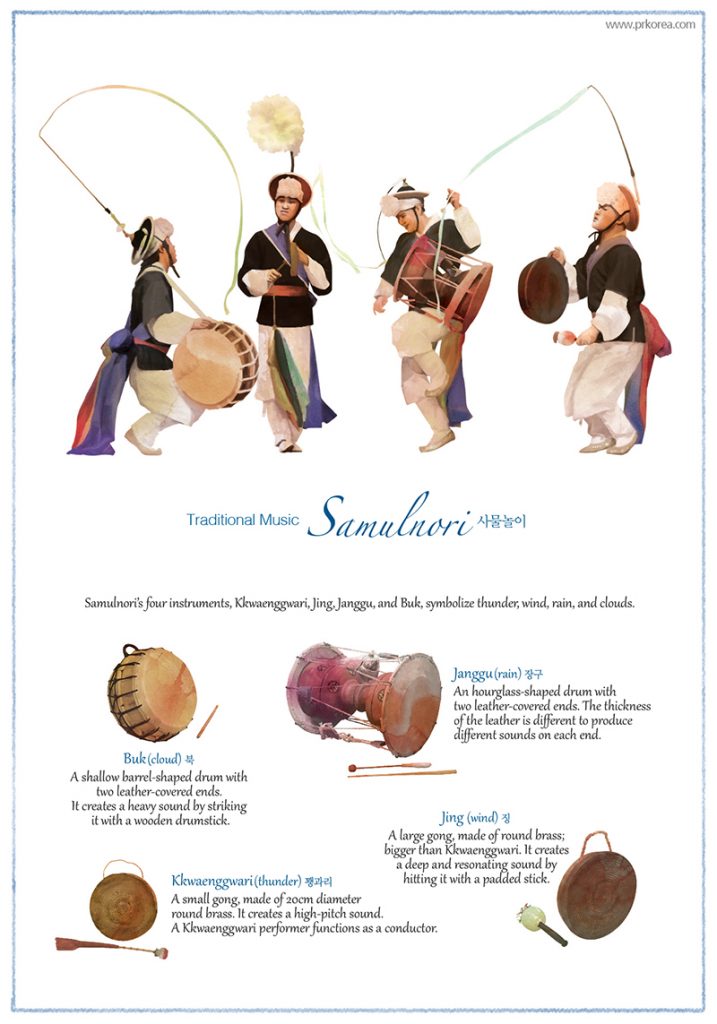 8. Traditional Music_Samulnori
8. Traditional Music_Samulnori
Samulnori is a Korean percussion ensemble that originated from Nongak or farmers’ folk music. Nongak was developed to raise morale or excitement during group work or for traditional holidays. Samulnori uses only four major percussion instruments, including Kkwaenggwari, Jing, Janggu, and Buk. Since its premier in 1978, Samulnori has gained widespread acclaim and popularity both in Korea and around the world. Nowadays, Samulnori is also performed with a jazz band or an orchestra.
Samulnori’s four instruments, Kkwaenggwari, Jing, Janggu, and Buk, symbolize thunder, wind, rain, and clouds.
Kkwaenggwari (thunder): A small gong, made of 20cm diameter round brass. It creates a high-pitch sound. A Kkwaenggwari performer functions as a conductor.
Jing (wind): A large gong, made of round brass; bigger than Kkwaenggwari. It creates a deep and resonating sound by hitting it with a padded stick.
Janggu (rain): An hourglass-shaped drum with two leather-covered ends. The thickness of the leather is different to produce different sounds on each end.
Buk (cloud): A shallow barrel-shaped drum with two leather-covered ends. It creates a heavy sound by striking it with a wooden drumstick.
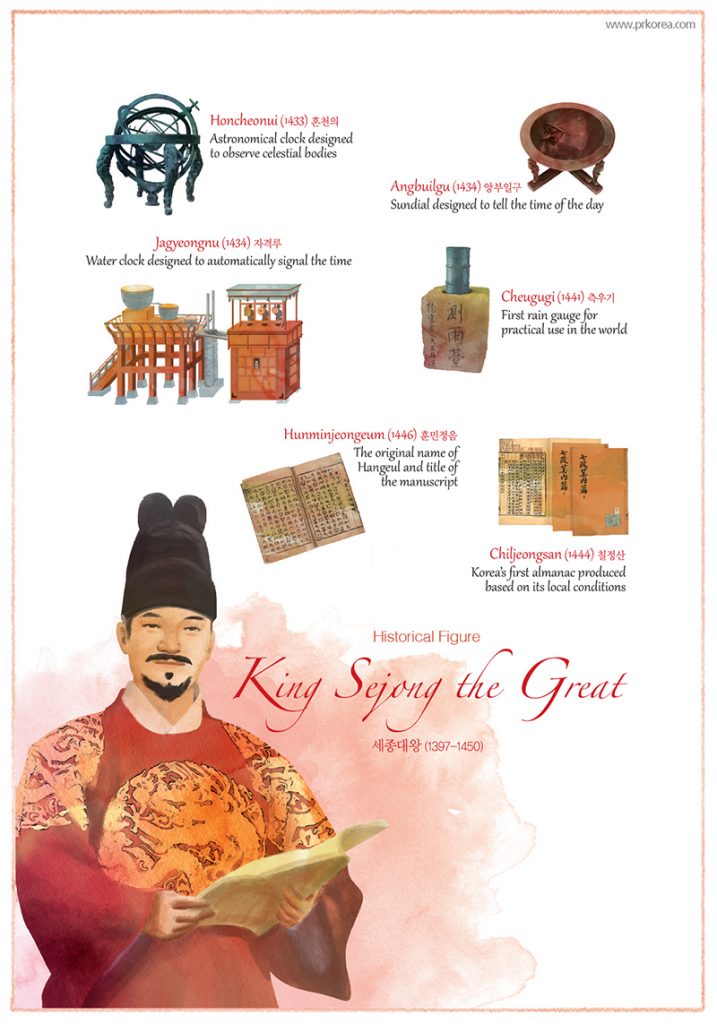 9. Historical Figure_King Sejong the Great
9. Historical Figure_King Sejong the Great
King Sejong the Great (1397-1450) was the fourth king of Joseon (1392~1910). He is the most respected historical figure in Korea. Through people-oriented policies, he made remarkable advancements across all areas, including politics, economy, culture, and military. While most countries in East Asia took China’s influence for granted, King Sejong was committed to developing Joseon’s unique culture, traditions, and technologies. Such commitment led to the invention of Hangeul in 1443. Hangeul is completely different from the Chinese alphabet. Ultimately, it enabled ordinary Korean people to express their ideas and thoughts in writing.
Honcheonui (1433): astronomical clock designed to observe celestial bodies.
Angbuilgu (1434): sundial designed to tell the time of the day.
Jagyeongnu (1434): water clock designed to automatically signal the time.
Cheugugi (1441): first rain gauge for practical use in the world.
Chiljeongsan (1444): Korea’s first almanac produced based on its local conditions.
Hunminjeongeum (1446): the original name of Hangeul and title of the manuscript.
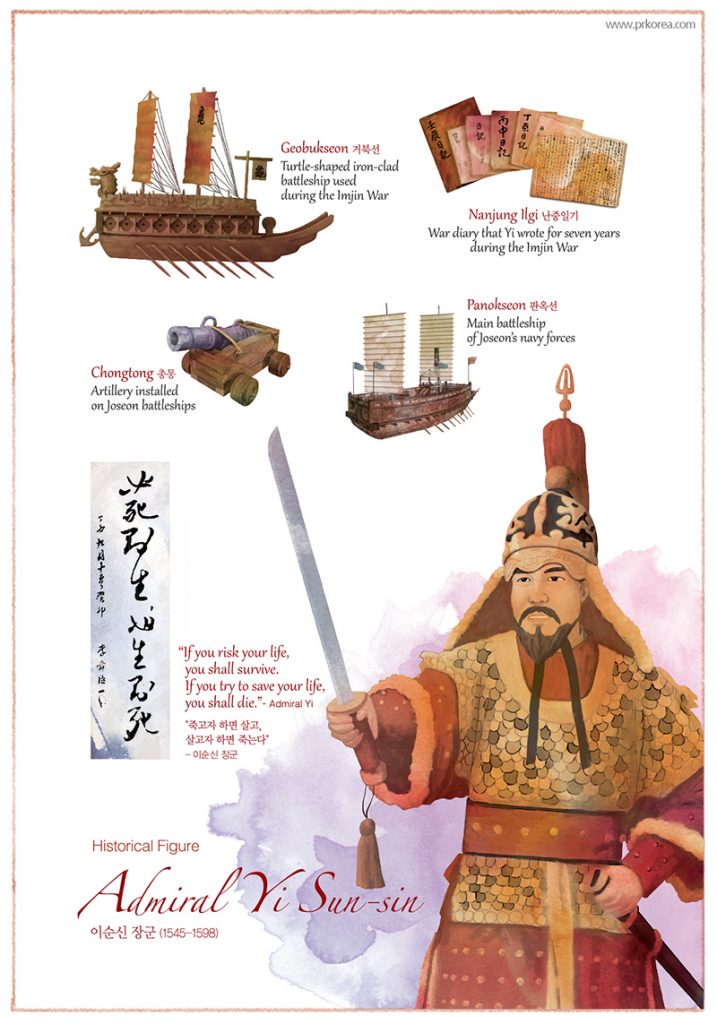 10. Historical Figure_Admiral Yi Sun-sin
10. Historical Figure_Admiral Yi Sun-sin
Yi Sun-sin (1545-1598) was a heroic naval commander, who saved the country from national crisis during the Imjin War (1592-1598). Japan’s invasion of Korea came as a surprise to most officials in Joseon. However, Yi foresaw Japan’s ambitions and made full preparations for potential attacks. He led all his battles to victory and turned the war situation in favor of Joseon. His foresight, wisdom, and patriotism are the reasons why the Korean people still admire Admiral Yi Sun-sin.
Geobukseon: turtle-shaped iron-clad battleship used during the Imjin War.
Nanjung Ilgi: war diary that Yi wrote for seven years during the Imjin War.
Panokseon: main battleship of Joseon’s navy forces.
Chongtong: artillery installed on Joseon battleships.
“If you risk your life, you shall survive. If you try to save your life, you shall die.”

